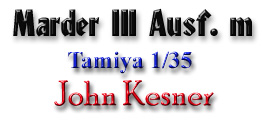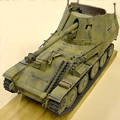|
In February of 1943, Hitler was informed that, following final testing, the new vehicle would be
ready for mass production very soon, and that production capabilities would number 150 per month
instead of the current 60 a month. Overjoyed, production did begin soon however these
numbers were not reached until October of that year. Production continued until May of
1944 with 975 units produced, when it was stopped in favor of the Jagdpanzer Hetzer.
|
|






![[The M model moved the engine forward allowing the gun to be moved to the rear.]](JK-M3m-04b.jpg)
![[975 units were produced from May of 43 till May of 44]](JK-M3m-05b.jpg)
![[The simple welded driver's compartment cover identifies a later model.]](JK-M3m-02b.jpg)
![[Note the scratch camouflage rings.]](JK-M3m-08a.jpg)
![[Rear View]](JK-M3m-011b.jpg)
![[The kit features the typical Tamiya quality, and would build into a nice kit right out of the box.]](JK-M3m-06a.jpg)
![[Jack Detail]](JK-M3m-07a.jpg)
![[The gun barrel and breach came from Blast.]](JK-M3m-09b.jpg)
![[The interior travel lock controller was also replaced.]](JK-M3m-010a.jpg)
![[The kit was painted with Model Master paints, and stencils were used instead of decals.]](JK-M3m-01b.jpg)
![[An overhead view.]](JK-M3m-012b.jpg)
![[Index]](../../../German-Cross.jpg)